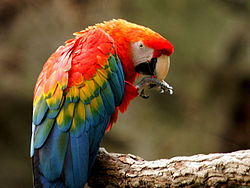Psittacidae
| Neotropical and Afrotropical parrots Temporal range: Template:Geological range
| |
|---|---|

| |
| Male scarlet macaw | |
| Scientific classification | |
| : | [[Template:Taxonomy/Psittacidae]] Rafinesque, 1815 |
| Subfamilies | |
|
See text for genera. | |
The family Psittacidae or holotropical parrots is one of three families of true parrots. It comprises the 12 species of subfamily Psittacinae (the Old World or Afrotropical parrots) and 169 of subfamily Arinae (the New World or Neotropical parrots) including several species that have gone extinct in recent centuries. Some of the most iconic birds in the world are represented here, such as the blue-and-yellow macaw among the New World parrots and the grey parrot among the Old World parrots.
Distribution[edit]
All of the parrot species in this family are found in tropical and subtropical zones and inhabit Mexico, Central and South America, the Caribbean islands, sub-Saharan Africa, the island of Madagascar, the Arabian Peninsula, Southeast Asia, Australia and Oceania. Two parrots, one extinct and the other extirpated, formerly inhabited the United States.[1]
Evolutionary history[edit]
This family probably had its origin early in the Paleogene period, 66–23 million years ago (Mya), after the western half of Gondwana had separated into the continents of Africa and South America, before the divergence of African and New World lineages around 30–35 Mya.[2] The New World parrots, and by implication Old World parrots, last shared a common ancestor with the Australian cockatoos in the family the Cacatuidae approximately 33 Mya.[3]
The data place most of the diversification of psittaciformes around 40 Mya, after the separation of Australia from West Antarctica and South America.[2][4] Divergence of the Psittacidae from the ancestral parrots resulted from a common radiation event from what was then West Antarctica into South America, then Africa, via late Cretaceous land bridges that survived through the Paleogene.[5]
Taxonomy[edit]
The family Psittacidae was introduced (as Psittacea) by French polymath Constantine Samuel Rafinesque in 1815.[6][7] The recently revised taxonomy of the family Psittacidae, based on molecular studies, recognizes the sister clade relationship of the Old World Psittacini and New World Arini tribes of subfamily Psittacinae,[8] which have been raised to subfamily ranking and renamed Psittacinae and Arinae. Subfamily Loriinae and the other tribes of subfamily Psittacinae are now placed in superfamily Psittacoidea of all true parrots, which includes family Psittacidae.[9]
The following phylogeny shows how the family Psittacidae relates to the three other families in the order Psittaciformes. The tree is based on the work by Leo Joseph and collaborators published in 2012 but with the choice of families and the number of species in each family taken from the list maintained by Frank Gill, Pamela Rasmussen and David Donsker on behalf of the International Ornithological Committee (IOC), now the International Ornithologists' Union.[9][10] Template:Clade
The family contains 181 species and is divided into 37 genera. Included are four species that have become extinct in historical times: the glaucous macaw, the Carolina parakeet, the Cuban macaw and the Puerto Rican parakeet. The following cladogram is based on a phylogenetic study by Brian Smith and collaborators that was published in 2023. In the analysis the genera Nannopsittaca, Bolborhynchus and Psilopsiagon were found not to be monophyletic.[3] The number of species in each genus is taken from the IOC list.[10]
- Subfamily Psittacinae
- Genus Bavaripsitta†
- Genus Psittacus – African grey parrots (two species)
- Genus Poicephalus
- Subfamily Arinae
- Tribe Arini – macaws and parakeets
- Genus Anodorhynchus
- Genus Cyanopsitta
- Genus Ara
- Genus Orthopsittaca
- Genus Primolius
- Genus Diopsittaca
- Genus Rhynchopsitta
- Genus Ognorhynchus
- Genus Guaruba
- Genus Leptosittaca
- Genus Conuropsis†
- Genus Psittacara
- Genus Aratinga
- Genus Eupsittula
- Genus Thectocercus
- Genus Cyanoliseus
- Genus Pyrrhura
- Genus Enicognathus
- Tribe Androglossini – Amazon and related parrots
- Genus Pyrilia
- Genus Pionopsitta
- Genus Graydidascalus
- Genus Alipiopsitta
- Genus Pionus
- Genus Amazona
- Genus Triclaria
- Clade (proposed tribe Amoropsittacini)
- Genus Nannopsittaca
- Genus Psilopsiagon
- Genus Bolborhynchus
- Genus Touit
- Clade (proposed tribe Forpini) – parrotlets
- Genus Forpus
- Clade including Arini
- Clade including Androglossini
- Genus Hapalopsittaca
- Genus Brotogeris
- Genus Myiopsitta
- Tribe Arini – macaws and parakeets
References[edit]
- ↑ Forshaw, J. (2000). Parrots of the World, 3rd Ed. Australia: Lansdowne. pp. 303, 385.
- ↑ 2.0 2.1 Schweizer, M.; Seehausen O; Hertwig ST (2011). "Macroevolutionary patterns in the diversification of parrots: effects of climate change, geological events and key innovations". Journal of Biogeography. 38 (11): 2176–2194. doi:10.1111/j.1365-2699.2011.02555.x. PMC 2727385. PMID 18653733.
- ↑ 3.0 3.1 Smith, B.T.; Merwin, J.; Provost, K.L.; Thom, G.; Brumfield, R.T.; Ferreira, M.; Mauck, W.M.I.; Moyle, R.G.; Wright, T.F.; Joseph, L. (2023). "Phylogenomic analysis of the parrots of the world distinguishes artifactual from biological sources of gene tree discordance". Systematic Biology. 72 (1): 228–241. doi:10.1093/sysbio/syac055.
- ↑ Wright, T.; et al. (Oct 2008). "A Multilocus Molecular Phylogeny of the Parrots (Psittaciformes): Support for a Gondwanan Origin during the Cretaceous". Molecular Biology and Evolution. 25 (10): 2141–2156. doi:10.1093/molbev/msn160. PMC 2727385. PMID 18653733.
- ↑ Remsen, Van. "Proposal (599) to South American Classification Committee: Revise classification of the Psittaciformes". Retrieved 17 December 2013.
- ↑ Rafinesque, Constantine Samuel (1815). Analyse de la nature ou, Tableau de l'univers et des corps organisés (in français). Palermo: Self-published. p. 64.
- ↑ Bock, Walter J. (1994). History and Nomenclature of Avian Family-Group Names. Bulletin of the American Museum of Natural History. Vol. Number 222. New York: American Museum of Natural History. pp. 140, 252. hdl:2246/830.
- ↑ Collar, N. (1997). Birds of the World, Vol.4. del Hoyo. p. 241.
- ↑ 9.0 9.1 Joseph, L.; Toon, A.; Schirtzinger, E.E.; Wright, T.F.; Schodde, R. (2012). "A revised nomenclature and classification for family-group taxa of parrots (Psittaciformes)". Zootaxa. 3205 (1): 26–40. doi:10.11646/zootaxa.3205.1.2.
- ↑ 10.0 10.1 Gill, Frank; Donsker, David; Rasmussen, Pamela, eds. (January 2023). "Parrots, cockatoos". IOC World Bird List Version 13.1. International Ornithologists' Union. Retrieved 16 June 2023.
